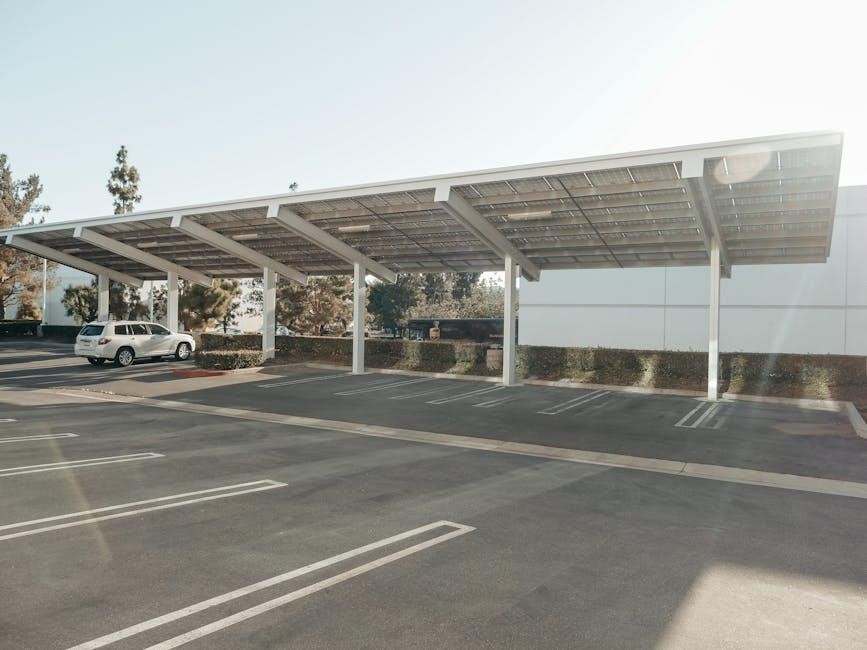
carport installation instructions
Carport Installation: A Comprehensive Guide
Embark on your carport project confidently! This comprehensive guide provides step-by-step carport installation instructions, addressing site preparation, foundation options, and assembly․ Whether using a DIY kit or custom materials, ensure proper leveling, anchoring, and panel placement for a durable, protective structure․ Follow these guidelines for a successful carport build․
Understanding Carport Types and Benefits
Before embarking on your carport installation, it’s crucial to understand the various types available and their respective benefits․ Carports offer protection from the elements, safeguarding vehicles from sun, rain, snow, and hail․ Common types include metal, steel, and aluminum carports, each offering varying levels of durability and weather resistance․ Metal carports, for instance, are known for their strength and longevity․
Consider the size and style that best suits your needs and property․ Options range from single to double carports, RV carports, and those designed to accommodate boats․ Furthermore, carports can be free-standing or attached to a building․
Beyond vehicle protection, carports can serve as covered outdoor spaces for gatherings or storage․ Understanding these types and benefits will help you choose the ideal carport for your specific requirements․ Ensure to research local building codes and regulations before making a final decision․ Free delivery and installation are frequently offered, simplifying the process․

Essential Tools and Materials for Carport Installation
Proper preparation is key to a successful carport installation․ Gathering the necessary tools and materials beforehand will streamline the process․ Essential tools include a level, measuring tape, drill with various bits, socket wrench set, hammer, safety glasses, work gloves, and a ladder․
Materials will depend on the carport type, but generally include posts, beams, panels, screws, bolts, anchors, and trim; For concrete foundations, you’ll need cement, gravel, and possibly rebar․ Ensure you have the correct type and quantity of fasteners as specified in the carport kit instructions․
Consider using a mobile app like The Home Depot’s to locate products and check inventory․ If installing on a ground surface, prepare leveling materials such as gravel or crushed stone․ Safety is paramount, so always wear safety glasses and gloves․ Having all tools and materials readily available will ensure a smooth and efficient carport installation․ Refer to your specific carport’s instructions for a comprehensive list․
Site Preparation: Leveling and Clearing the Ground
Before commencing any carport installation, meticulous site preparation is crucial for a stable and long-lasting structure․ The first step involves clearing the area of any vegetation, rocks, debris, or obstructions․ Remove any grass or topsoil to expose a firm, compact surface․
Next, assess the existing ground level․ Carports require a level foundation to ensure proper alignment and prevent structural issues․ Use a level and measuring tape to identify any high or low spots․ For minor unevenness, you can use a shovel to remove excess soil from high areas and fill low areas with compacted gravel or crushed stone․
For more significant slopes, consider renting a plate compactor to ensure the fill material is properly compacted․ The Versatube carport frame, for instance, benefits from a foundation that is level side-to-side and sloped slightly (about 1/8 inch per foot) front-to-back or back-to-front for drainage․ Precise leveling contributes significantly to the carport’s overall stability and prevents potential problems down the road․

Foundation Options: Concrete, Gravel, or Ground Installation
Selecting the appropriate foundation is vital for your carport’s stability․ Concrete slabs offer the most robust and durable option, providing a level, permanent base․ This involves pouring a concrete pad, ensuring it’s at least 10 cm thick, and properly cured․ Concrete anchors are then used to secure the carport to the slab․
Gravel foundations offer a more permeable and cost-effective alternative․ After leveling the ground, a layer of compacted gravel provides a stable base, allowing for drainage and preventing water accumulation․ Ground installation, the simplest option, involves directly anchoring the carport to the earth using rebar or auger anchors․
However, this method is best suited for temporary carports or areas with stable soil․ Consider soil conditions and local building codes when choosing your foundation․ While carports can be installed over grass or stones, ensure proper anchoring for wind resistance․ Ultimately, the best foundation depends on your budget, soil type, and desired permanence․
Step-by-Step Assembly Instructions for Metal Carports
Assembling a metal carport involves a systematic approach․ First, carefully unpack all components and verify against the parts list․ Begin by constructing the frame, connecting posts and beams according to the manufacturer’s instructions․ Ensure all connections are securely bolted and tightened․
Next, raise the frame and position it on the prepared foundation․ Attach base rails to the posts, ensuring they are level and square․ With the frame secured, proceed to install the roof panels, overlapping them correctly for weather protection․ Fasten the panels to the frame using self-drilling screws or appropriate fasteners․
Finally, install any trim or finishing elements to complete the structure․ Regularly check for plumb and level throughout the assembly process․ Refer to the manufacturer’s manual for specific torque specifications and fastening patterns․ Remember safety first and wear appropriate protective gear․ A well-assembled carport provides durable shelter for years to come․
Anchoring the Carport: Ensuring Stability and Safety
Proper anchoring is paramount for a carport’s stability and safety․ Select anchors appropriate for your foundation type—concrete, gravel, or ground․ For concrete slabs, use concrete anchors or wedge anchors, ensuring they penetrate deep enough for secure grip․ Drill pilot holes accurately to prevent cracking․
For gravel or ground installations, employ ground anchors like rebar anchors or auger anchors․ These anchors need to reach a solid soil layer to resist wind uplift․ Space anchors according to the manufacturer’s guidelines, typically at each post and along the base rails․ Ensure the anchors are driven straight and deep into the ground․
For enhanced stability, consider using cable bracing or additional anchoring in high-wind areas․ Regularly inspect the anchors for any signs of loosening or corrosion․ Re-tighten or replace them as needed to maintain the carport’s structural integrity․ Proper anchoring ensures your carport remains secure and protects your vehicles from the elements․
Installing Panels and Trim for a Finished Look
Installing panels and trim elevates a carport from functional to aesthetically pleasing․ Begin by carefully positioning the roof panels, ensuring proper overlap to prevent leaks․ Secure the panels using self-tapping screws, following the manufacturer’s recommended spacing․ Over-tightening can damage the panels, so apply consistent pressure․
Next, install the wall panels if your design includes them․ These panels enhance protection from the elements and add visual appeal․ Ensure the panels are aligned correctly and securely fastened to the frame․ Use appropriate flashing around openings to prevent water intrusion․
Finally, add the trim to conceal any exposed edges and create a clean, finished look․ Trim pieces are typically attached with screws or rivets․ Pay close attention to corners and seams, ensuring a snug fit․ Choose trim colors that complement the panels and overall design․ This attention to detail results in a professional-looking, durable carport․
Color Selection and Customization Options
Choosing the right colors and customizations transforms a standard carport into a personalized structure․ With a wide array of colors available for side panels, walls, and trim, you can match your carport to your home or express your unique style․ Consider the surrounding environment and select colors that blend harmoniously or create a striking contrast․
Beyond color, customization options include adding doors, windows, or even extending the carport to accommodate larger vehicles or create additional storage space․ Explore various panel styles, such as vertical or horizontal, to achieve the desired aesthetic․ Integrate lighting fixtures for enhanced visibility and security․ Consider adding gutters and downspouts to manage rainwater runoff․
By carefully considering these customization options, you can create a carport that not only protects your vehicles but also enhances the overall appeal of your property․ Take advantage of online tools and visualizers to experiment with different combinations and bring your vision to life․
DIY vs․ Professional Carport Installation: Weighing the Pros and Cons

Deciding between DIY and professional carport installation requires careful consideration of your skills, time, and budget․ DIY installation offers cost savings and a sense of accomplishment, but demands expertise in construction, tool proficiency, and physical stamina․ It involves site preparation, foundation work, assembly, and anchoring, potentially consuming significant time․
Professional installation guarantees expertise and efficiency, ensuring proper construction and adherence to safety standards․ Professionals handle permits, site preparation, and assembly, saving you time and effort․ However, it involves higher upfront costs․ Consider factors like warranty coverage and potential liability for errors․ Assess your comfort level with complex construction tasks and the value you place on professional assurance․
Evaluate the complexity of the carport design, site conditions, and your familiarity with local building codes․ By weighing the pros and cons, you can make an informed decision that aligns with your needs and capabilities․

Precautions and Considerations Before Installation
Before embarking on carport installation, several precautions and considerations are crucial for a successful and safe project․ First, obtain necessary building permits from your local municipality to ensure compliance with zoning regulations and construction codes․ Neglecting this step can lead to fines or removal orders․ Thoroughly inspect the installation site, identifying underground utilities, such as gas, water, or electrical lines, to prevent accidental damage during excavation or anchoring․
Assess soil conditions to determine appropriate foundation requirements․ Unstable soil may necessitate additional reinforcement or specialized anchoring techniques․ Verify property lines to avoid encroaching on neighboring properties․ Consider environmental factors, such as wind exposure and snow load, to select a carport design and materials that can withstand local weather conditions․ Review manufacturer’s instructions meticulously to ensure proper assembly and avoid structural issues․
Prioritize personal safety by wearing appropriate protective gear, including safety glasses, gloves, and sturdy footwear․ Enlist assistance from others when handling heavy components to prevent injuries․ By addressing these precautions and considerations beforehand, you can minimize risks and ensure a smooth and secure carport installation process․
Related Posts

dream on me synergy 5-in-1 convertible crib instructions
Need help setting up your Dream On Me Synergy 5-in-1 crib? Find clear, step-by-step instructions & ensure a comfy, secure sleep space for your little one. Let’s build!

compare n save grass and weed killer mixing instructions
Learn how to mix grass and weed killer effectively while saving money. Get expert tips and compare products to keep your lawn healthy and weed-free.

suddenly salad bacon ranch instructions
Craving Suddenly Salad Bacon Ranch? Skip the mystery! Get foolproof instructions, plus tips to make it *amazing*. Dinner’s solved!